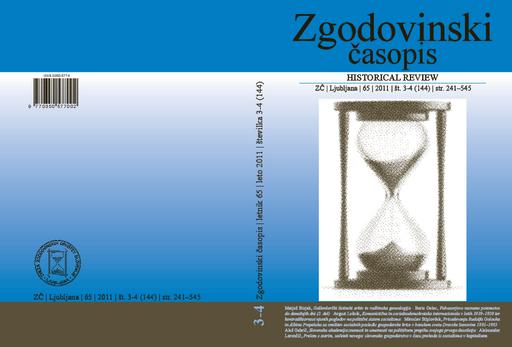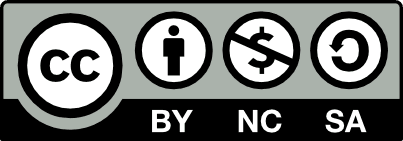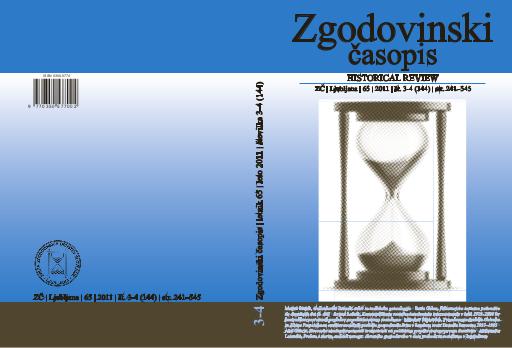/
Periodicals
/
Zgodovinski časopis
A Break with the Old and the Beginning of Something New: Slovene Economy during the Period of Transition from Socialism to Capitalism

Author(s):Aleksander Lorenčič
Co-author(s):Peter Štih (odg. ur.), Dušan Mlacović (ur.), Bojan Balkovec (teh. ur.), ives Sulič Dular (prev.), Niko Hudelja (prev.)
Year:2011
Publisher(s):Zveza zgodovinskih društev Slovenije, Ljubljana
Source(s):Zgodovinski časopis, 2011, št. 3-4
Language(s):slovenščina
Type(s) of material:text
Keywords:Jugoslavija, Slovenija, gospodarstvo, razpad, tranzicija, kriza, okrevanje, Yugoslavia, Slovenia, economy, dissolution, transition, crisis, recovery
Rights:

This work by Aleksander Lorenčič is licensed under Creative Commons Attribution-NonCommercial-ShareAlike 4.0 International
Files (1)

Name:ZC_2011_3-4.pdf
Size:3.88MB
Format:application/pdf
Permanent link:https://hdl.handle.net/11686/file18353
Description
Prior to its proclamation of an autonomous and independent state in 1991, Slovenia was a
part of the Yugoslav federation and of its economic system based on public ownership and planned
economy. In many respects, however, its initial position was more favorable than that of other
countries in transition. By that time, Slovenia had namely developed many market elements. Its
trading of goods was not limited solely to Eastern markets and its technological development
was already on a higher level than in other socialist countries. Since the formation of prices
and production had already largely adopted the principles of market economy politics played a
less pronounced role in economic activities; contrary to this, the distinct influence of politics in
human resources policy had been felt until the last days of the Yugoslav federation. Requests
for change, which officially started in the spring of 1990, had been increasingly voiced since
the second half of the 1980s. In the 1990-1992 period, Slovenia held a plebiscite, proclaimed independence, experienced a ten-day war, became internationally recognized, and ultimately
became an autonomous state. The decision to become an autonomous and independent country
enabled Slovenia to start implementing its own economic policy and thus assume responsibility
for its economic development. The priority during this first phase of transition was to establish
essential elements and institutions necessary for a successful function of a democratic country
governed by the rule of law. Slovenia was among the first countries that were able to successfully
overcome the period of transformational depression so typical of transitional economies at the
beginning of the 1990s. The recovery of its economic growth and invigoration of domestic demand
started to take place already in the middle of 1993. In a relatively short time it exceeded
its pre-transitional level of economic activities; the level from 1990 was surpassed in 1996, and
the level from 1987 in 1998. In the first half of the 1990s, the young country also managed to
become a member of almost all prominent economic associations. There were marked structural
shifts in ownership and scale structures. The activity-based added value structure indicated a
decrease in industry and an increased importance of the service sector. As in other countries
in transition, the most burning difficulties concerned the process of privatization. But Slovenia
successfully overcame the transition from socialist to capitalist economy, with its economy
becoming increasingly competitive and comparable to developed market economies.
Metadata (12)
- identifierhttps://hdl.handle.net/11686/35032
- title
- Prelom s starim, začetek novega: slovensko gospodarstvo v času prehoda iz socializma v kapitalizem
- A Break with the Old and the Beginning of Something New: Slovene Economy during the Period of Transition from Socialism to Capitalism
- creator
- Aleksander Lorenčič
- contributor
- Peter Štih (odg. ur.)
- Dušan Mlacović (ur.)
- Bojan Balkovec (teh. ur.)
- ives Sulič Dular (prev.)
- Niko Hudelja (prev.)
- subject
- Jugoslavija
- Slovenija
- gospodarstvo
- razpad, tranzicija
- kriza
- okrevanje
- Yugoslavia
- Slovenia, economy
- dissolution
- transition
- crisis
- recovery
- description
- Potem ko so se razmere v slovenskem gospodarstvu v drugi polovici osemdesetih let 20. stoletja iz leta v leto slabšale in ko je postalo jasno, da so razvojne možnosti za slovensko gospodarstvo v okviru tedanjega sistema omejene, se je aprila leta 1990 z večstrankarskimi volitvami tudi uradno začela tranzicija. Poleg tega, da se je Slovenija v prvem obdobju tega izredno zahtevnega procesa spopadala z recesijo, makroekonomsko nestabilnostjo in upadanjem življenjskega standarda, je bila naloga njene ekonomske politike vzpostaviti vse elemente in institucije za uspešno delovanje demokratične in v tržno gospodarstvo usmerjene države.
- The state of Slovene economy became increasingly worse in the second half of the 1980s. Once it became obvious that the possibilities of economic development in Slovenia were quite limited within the then existing system of government the multiparty elections of April 1990 heralded the official beginning of the period of transition. During the initial period of this extremely demanding process Slovenia had to battle recession, macroeconomic instability, and a decreased standard of living. Its economic policy focused primarily on establishing elements and institutions required for a successful operation of the country intent on market economy.
- Prior to its proclamation of an autonomous and independent state in 1991, Slovenia was a part of the Yugoslav federation and of its economic system based on public ownership and planned economy. In many respects, however, its initial position was more favorable than that of other countries in transition. By that time, Slovenia had namely developed many market elements. Its trading of goods was not limited solely to Eastern markets and its technological development was already on a higher level than in other socialist countries. Since the formation of prices and production had already largely adopted the principles of market economy politics played a less pronounced role in economic activities; contrary to this, the distinct influence of politics in human resources policy had been felt until the last days of the Yugoslav federation. Requests for change, which officially started in the spring of 1990, had been increasingly voiced since the second half of the 1980s. In the 1990-1992 period, Slovenia held a plebiscite, proclaimed independence, experienced a ten-day war, became internationally recognized, and ultimately became an autonomous state. The decision to become an autonomous and independent country enabled Slovenia to start implementing its own economic policy and thus assume responsibility for its economic development. The priority during this first phase of transition was to establish essential elements and institutions necessary for a successful function of a democratic country governed by the rule of law. Slovenia was among the first countries that were able to successfully overcome the period of transformational depression so typical of transitional economies at the beginning of the 1990s. The recovery of its economic growth and invigoration of domestic demand started to take place already in the middle of 1993. In a relatively short time it exceeded its pre-transitional level of economic activities; the level from 1990 was surpassed in 1996, and the level from 1987 in 1998. In the first half of the 1990s, the young country also managed to become a member of almost all prominent economic associations. There were marked structural shifts in ownership and scale structures. The activity-based added value structure indicated a decrease in industry and an increased importance of the service sector. As in other countries in transition, the most burning difficulties concerned the process of privatization. But Slovenia successfully overcame the transition from socialist to capitalist economy, with its economy becoming increasingly competitive and comparable to developed market economies.
- publisher
- Zveza zgodovinskih društev Slovenije
- date
- 2011
- type
- besedilo
- language
- Slovenščina
- isPartOf
- rights
- license: ccByNcSa
Citirano v (1)
| Tipologija | Avtor(ji) | Naslov | Kraj | Založba | Leto |
|---|---|---|---|---|---|
| 1.01 Izvirni znanstveni članek | Šela, Ana | Contributions to the knowledge of the Slovenian intellectual "opposition" in the 1980s under the screening of the State Security Service | Koper | Zgodovinsko društvo za južno Primorsko : Znanstveno raziskovalno središče Republike Slovenije | 2021 |
Seznam literature v delu (29)
| Stran | Avtor | Naslov | Vir | Kraj | Založba | Leto |
|---|---|---|---|---|---|---|
| 477 | Babič, Blaž | Predvolilni gospodarski program koalicije Demos | Prispevki za novejšo zgodovino | Ljubljana | 2009 | |
| 477 | Borak, Neven | Ekonomski vidiki delovanja in razpada Jugoslavije | Ljubljana | Znanstveno in publicistično središče | 2002 | |
| 477 | Borak, Neven | Slovenske transformacije: kontinuiteta v spremembah | Gospodarske krize in Slovenci | Ljubljana | Inštitut za novejšo zgodovino/Zveza ekonomistov Slovenije/Ekonomska fakulteta | 1999 |
| 477 | Borak, Neven | Spočetje ekonomske samostojnosti | Ljubljana | Znanstveno in publicistično središče | 1992 | |
| 477 | Čepič, Zdenko | Gospodarska kriza | Slovenska novejša zgodovina 2, Od programa Zedinjena Slovenija do mednarodnega priznanja | Ljubljana | MK | 2005 |
| 477 | Hribernik, Franc | Socialna vamost brezposelnih: Socialno delo | Ljubljana | 1995 | ||
| 477 | Jovič, Dejan | Jugoslavija - država koja je odumrla. Uspon, kriza i pad četvrte Jugoslavije (1974-1990) | Zagreb/Beograd | Prometej | 2003 | |
| 477 | Judt, Tony | Povojna Evropa 1945-2005 | Ljubljana | MK | 2007 | |
| 477 | Kovač, Bogomir | Rekviem za socializem. Ekonomske reforme v socialističnih državah | Ljubljana | DZS | 1990 | |
| 477 | Kovač, Bogomir | Rekviem za socializem. Ekonomske reforme v socialističnih državah | Ljubljana | DZS | 1990 | |
| 477 | Krašovec, Tone | Deset let gospodarskega razvoja v samostojni Sloveniji | Ljubljana | Združenje Manager | 2001 | |
| 477 | Lazarevič, Žarko | Plasti prostora in časa. Iz gospodarske zgodovine Slovenije prve polovice 20. stoletja | Ljubljana | Inštitut za novejšo zgodovino | 2009 | |
| 477 | Lazarevič, Žarko | Prostor, gospodarstvo, in razmerja. Jugoslovanski ekonomski prostor in razmerja | Prispevki za novejšo zgodovino | 2009 | ||
| 477 | Lorenčič, Aleksander | Gospodarska kriminaliteta: »Temna stran kulturnega in tehnološkega razvoja človeštva« | Zgodovina za vse | 2009 | ||
| 477 | Aleksander, Lorenčič | Makroekonomski kazalci Slovenije v času tranzicije: od recesije in stabilizacije preko okrevanja do vstopa v Evropsko unijo | Časopis za zgodovino in narodopisje | 2009 | ||
| 477 | Lorenčič, Aleksander | Pretvorba družbene lastnine v privatno - osrednji problem slovenske gospodarske tranzicije | Prispevki za novejšo zgodovino | 2009 | ||
| 477 | Lorenčič, Aleksander | Pretvorba družbene lastnine v privatno: privatizacija stanovanj in denacionalizacija | Prispevki za novejšo zgodovino | 2010 | ||
| 478 | Lorenčič, Aleksander | Prva leta gospodarske tranzicije v Sloveniji | Prispevki za novejšo zgodovino | 2008 | ||
| 478 | Lorenčič, Aleksander | Strukturni premiki na področju slovenskega podjetništva v času "prve recesije" | Zgodovina za vse | 2009 | ||
| 478 | Mencinger, Jože | Deset let pozneje. Tranzicija - uspeh, polom ali nekaj vmes? Gospodarska gibanja | Ekonomski inštitut pravne fakultete | 2000 | ||
| 478 | Mencinger, Jože | Plesala je eno polletje | Gospodarski vestnik | 1992 | ||
| 478 | Prinčič, Jože ; Borak, Neven | Iz reforme v reformo. Slovensko gospodarstvo 1970-1991 | Ljubljana | Fakulteta za družbene vede | 2006 | |
| 478 | Prinčič, Jože | Gospodarski vidiki osamosvajanja Slovenije (1986-1991) | Slovenska osamosvojitev 1991. Pričevanja in analize. Simpozij Brežice, 21 -22.junij 2001 | Ljubljana | Zveza zgodovinskih društev Slovenije | 2002 |
| 478 | Repe, Božo | Jutri je nov dan. Slovenci in razpad Jugoslavije | Ljublajna | Modrijan | 2002 | |
| 478 | Repe, Božo | Razmere v Sloveniji do leta 1989. Osamosvojitev Slovenije - 15 let kasneje | Maribor | 2006 | ||
| 478 | Repe, Božo | Slovenci v osemdesetih letih. Zbirka zgodovinskega časopisa - 23. | Ljubljana | Zveza zgodovinskih društev Slovenije | 2001 | |
| 478 | Štiblar, Franjo | Razvoj trgov Ex-Jugoslavije, Gospodarska gibanja | Ljubljana | Ekonomski inštitut pravne fakultete | 1995 | |
| 478 | Stoka Debevec, Meta | Plačna politika od leta 1990 dalje ter razlogi zanjo | Slovenska ekonomska revija | 1997 | ||
| 478 | Vodopivec, Peter | Od Pohlinove slovnice do samostojne države. Slovenska zgodovina od konca 18. stoletja do konca 20. stoletja | Ljubljana | Modrijan | 2006 |
